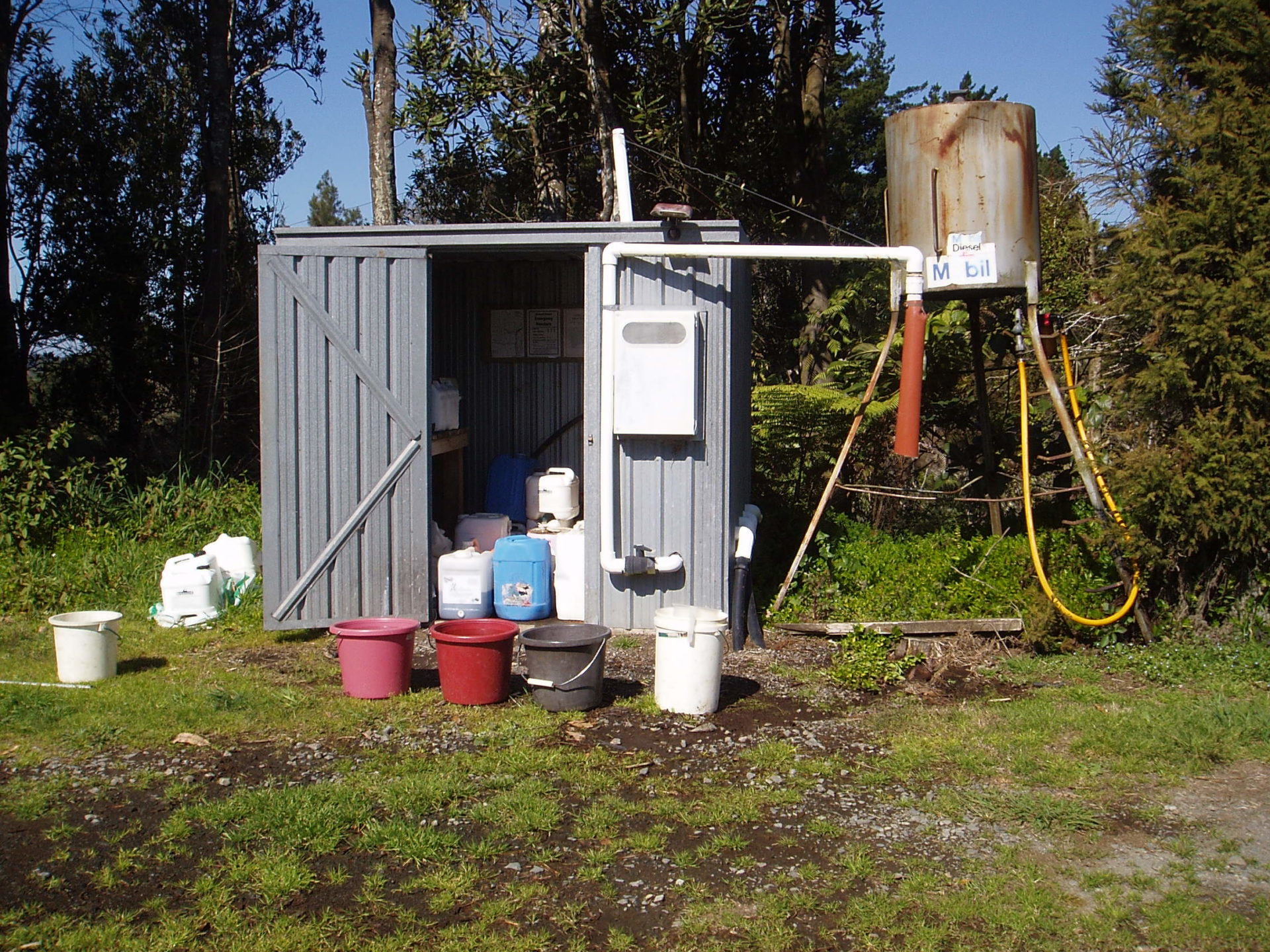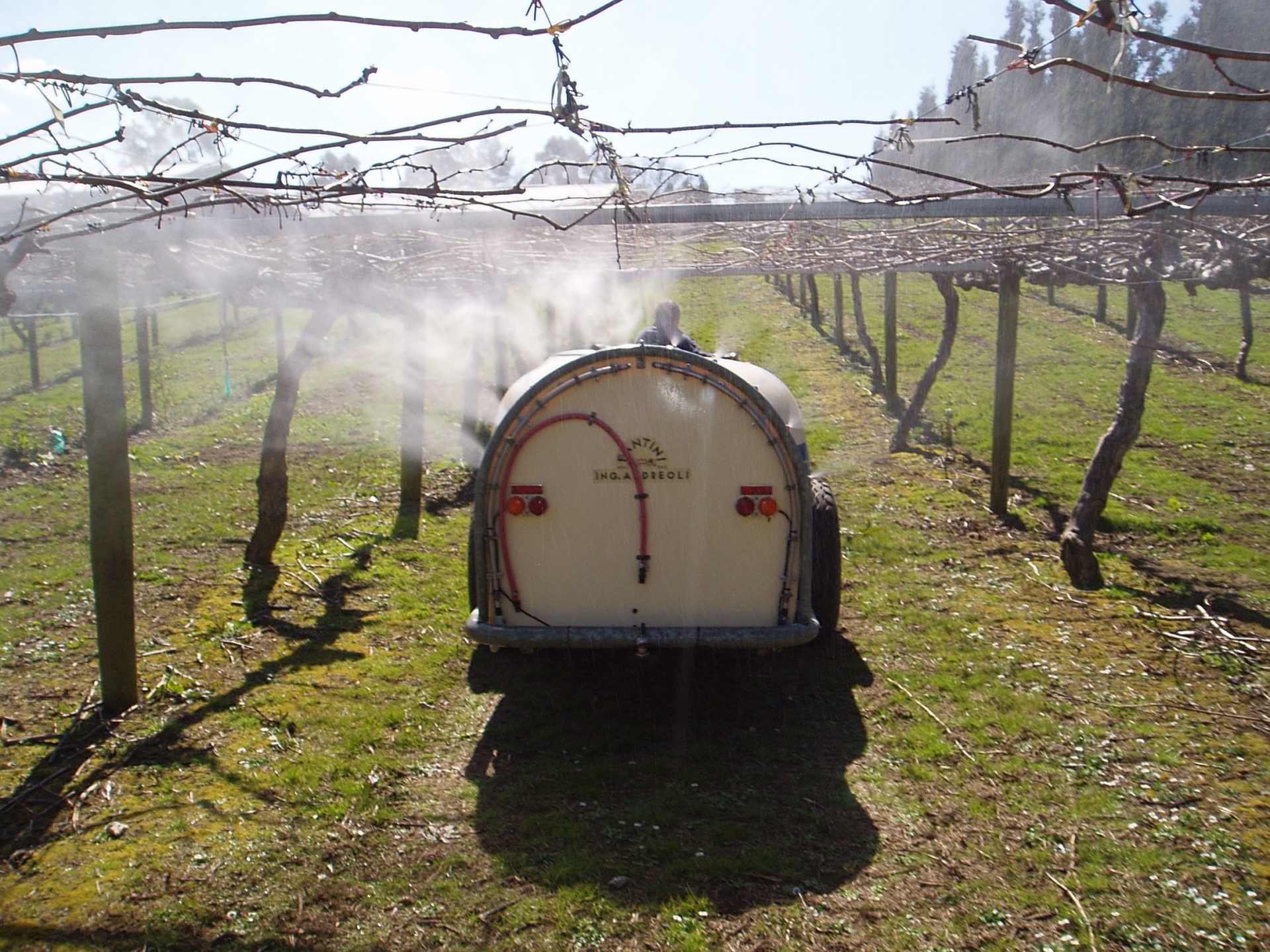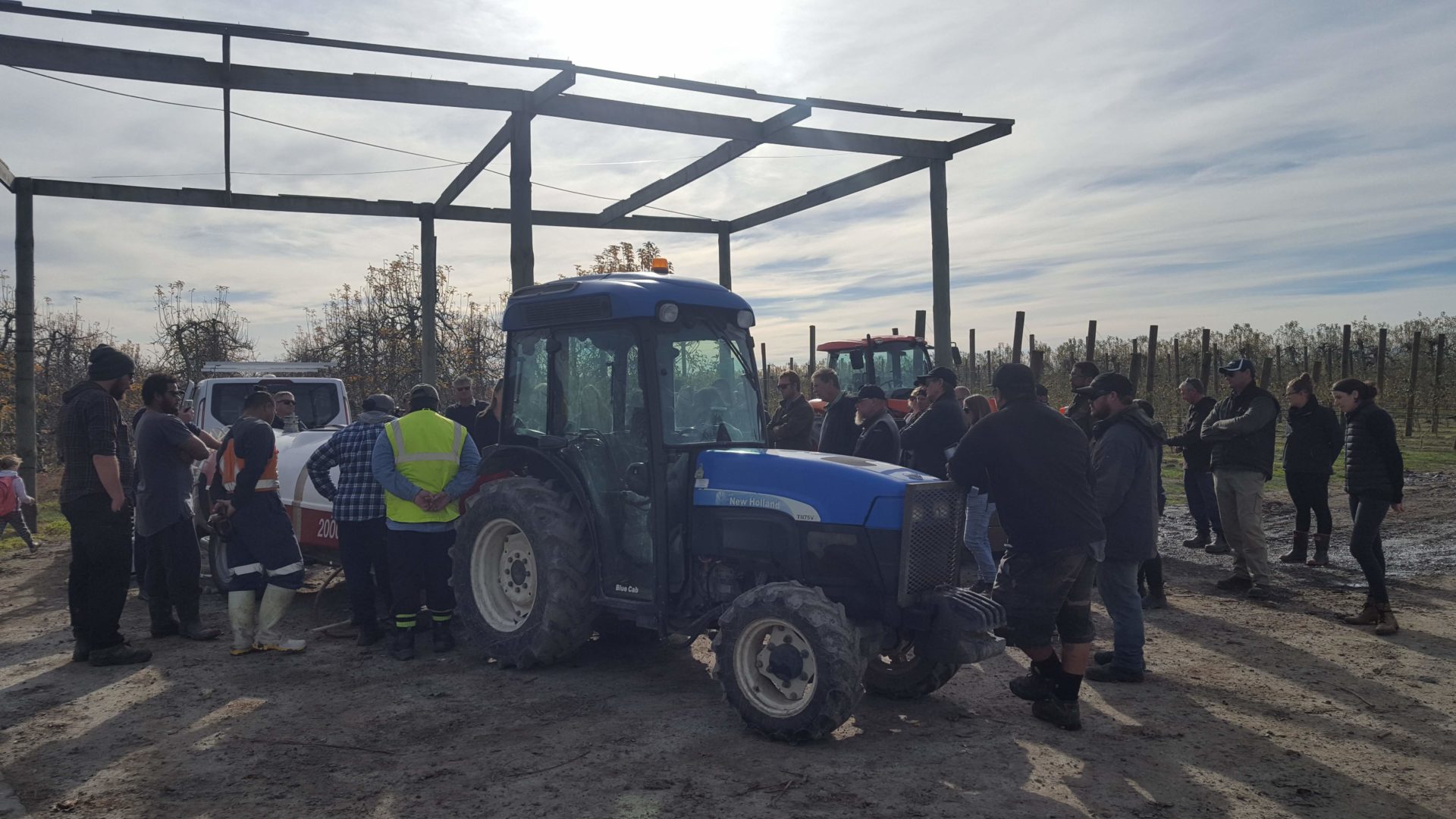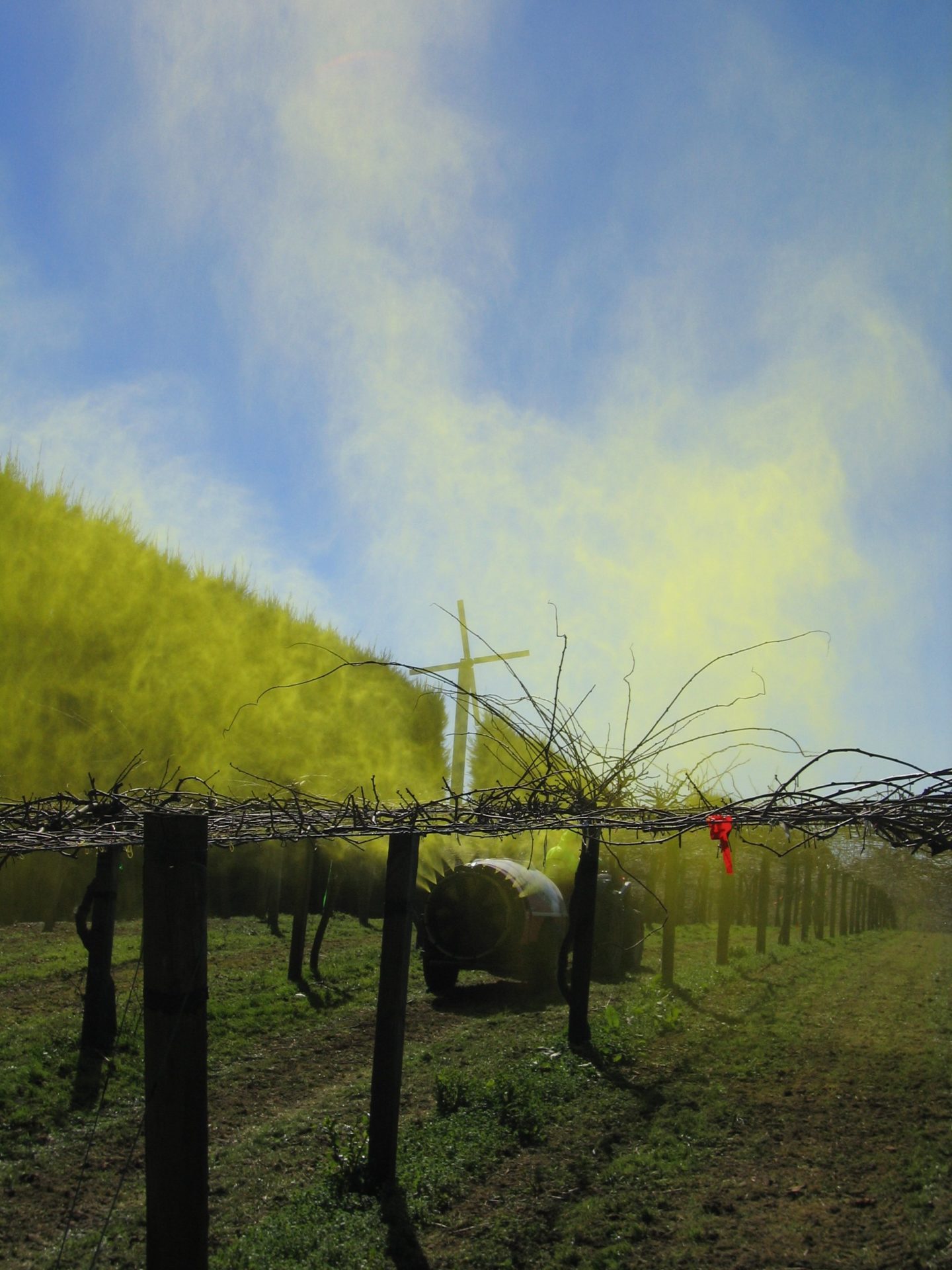Spray and know it’s OK
As first seen in the Orchardist, February 2020
By Andy Mawley, David Manktelow and Jane Labm
Agrichemicals are essential inputs in the production of virtually all horticultural crops – in both conventional and organic production systems. Almost all agrichemicals used in NZ are hazardous in some way and their use is controlled under NZ legislation. The legal, safe, effective and responsible use of agrichemicals is achieved by trained users following product label instructions and the guidelines for use in the NZ Standard (NZS 8409 Management of agrichemicals).
The NZ legislation and requirements around agrichemical user training have had some significant changes and it is important that all agrichemical users understand what is now expected of them and what they can do to meet these expectations.
The bad old days – agrichemicals stored in a pump shed with no bunding around the well head and fuel lank alongside!
All hazardous substances in NZ are given hazard classifications based on their physical (e.g. flammability) and biological (e.g. human or eco-toxicity) hazards. The HSWA legislation requires that a range of “controls” are implemented for different hazards, hazard levels and quantities of hazardous substances in your workplace. The critical controls for agrichemicals relate to user training, storage, personal protection and management of application into the environment.
Positive changes
There are are two important changes that will affect agrichemical users:
- The former Approved Handler training and certification requirements have been replaced with a new and higher level Certified Handler
Certified Handler training is only required for the most toxic agrichemicals that receive the highest 6.1A and 6.1B hazard classifications. In practice only a very few agrichemicals (eg paraquat herbicide and chlorothalonil fungicide) have 6.1A or B human toxicity ratings, and many of these are in the process of being phased out of use in NZ.
Most properties will not need to have Certified Handlers on site. If they do, Growsafe offers training for certified handlers, with the final certification process completed by registered compliance certifiers in a site visit.
2. There is a wider range of Growsafe courses on offer.
In NZ, as in most other countries, agrichemical users require some training before they are allowed to transport, store, use and dispose of agrichemicals. In practice there are different levels of responsibility between different agrichemical users. For example, a tractor driver working under supervision requires a lower level of training than the person who is responsible for running a pest and disease management programme and making chemical selection and timing decisions.
Kiwifruit sprayer fitted with fine droplet nozzles (LHS) and low drift air inclusion nozzles (RHS) both delivering 600 I per ha
In the past the former Approved Handler certificate was bundled together with the Growsafe Introductory certificate and there were very few options available for lower and higher-level training. Growsafe now offers a Basic certificate for those operating under supervision, a Standard for those with responsibility for a workplace and an Advanced for those managing more complex operations, plus specialist certificates in areas like sprayer calibration.
The Growsafe programme was started in 1992 by the NZ Agrichemical Education Trust (NZAET) to facilitate the safe, effective and responsible use of agrichemicals in NZ through advocacy and education. It is a charitable trust with representation from key horticultural sectors including Zespri, NZ Apples & Pears, NZ Winegrowers and Horticulture NZ. Its challenge is to deliver relevant, useful and affordable training programmes to industry.
Participation in the global food supply industry requires the establishment of good practices and the ability to prove that they have followed – with programmes like GlobalG.A.P. and New Zealand GAP ultimately of benefit to us all. These programmes make us aware of our responsibilities, from regional air plans, to the legal requirements around agrichemical use. Establishing and following good management programmes will help avoid any potential negative consequences from agrichemical use.
NZAPI Educational Day at Blyth Orchard, Hastings
There is a real challenge in making information available to the people who actually need it, and in a form that it can be readily understood and followed. For example, council air plans contain different regional requirements for agrichemical users and these need to be interpreted in your property spray plans. These spray plans should be living documents that are used as part of every spray round and should and not just sit in a file in the main office for GAP audits.
Reading Product Labels
The agrichemical label is the most important source of information on how to safely and effectively use agrichemicals.
- Do you properly check the label every time you spray?
- Do you understand the product’s hazard classifications and how to interpret them?
- Do you know what personal protection equipment is needed and how and when to use it?
- How might the chemical cause harm off-target and how can risks of off-target movement be avoided?
- How much of a particular chemical can you transport and how does it need to be loaded?
- Is a particular agrichemical a tracked substance and if so, what are you required to do?
Sometimes the most basic practices can trip people up and it is important that we don’t just assume that agrichemical users know how to do everything. For example:
- Do they know how to pour out or weigh chemical properly and safely and do they have the right equipment available to do so?
- Do they use the right personal protective equipment (PPE) when mixing and applying chemicals?
- Is there an appropriate spill kit and first aid kit on site and do you know how to use them?
The information you need about PPE, mixing, storage, transport and emergency management can mostly be found on product labels and the Growsafe Basic and Standard courses place a lot of emphasis on teaching users how to find information on labels and how to interpret it and put it into practice.
Knowing your target and achieving effective pest, disease or weed control
Are you using the right chemical for your target? What else may it affect? How is it best applied to get the desired result without risking residues or crop damage? Are there any environmental affects? There are many questions that need to be addressed before applying an agrichemical and the knowledge that you need is built up with experience and advice. Application and agrichemical technology changes and improves all the time and best practice is a constantly moving target.
Old fashioned high drift risk spraying using fine droplet spray nozzles in dormant kiwifruit vines
Realistically there simply isn’t time on a one-day Growsafe Standard (was Introductory) course to cover much information on product modes of action and formulation, spray programmes and application technology. NZAET is working to develop a modular Growsafe Advanced Certificate that contains information specific to different sectors and application technology. These courses are designed to be undertaken over time by agrichemical users that are responsible for making decisions about product selection and application. The new modules will combine online self-paced study options, with face to face training sessions and acknowledgement of attendance at endorsed industry workshops and related training sessions.
Effective spray application and integration of training options
Improvements in sprayer, nozzle and adjuvant technology mean that is it possible to walk a practical line between achieving and maintaining a high level of pest, disease or weed control with minimal risk of off target losses and environmental harm. Likewise, there have been some real advances in crop planting and training systems that require changes from traditional application methods.
The technology exists, but an effective training package to assist in technology implementation for different sectors has been largely missing from the NZ industry. The new Growsafe Advanced training modules aim to help bridge this gap at a practical level relevant to users.
The NZ wine industry has been running an annual extension programme of practical “Spray Days” around NZ for the last four years. This programme has been attended by nearly 1000 vineyard staff each year with a focus on practical disease, pest and weed management issues. Last year a pilot two-day advanced course was run in Blenheim that focussed on “decision makers”. The plan now is to acknowledge industry-based extension work like this in the Growsafe programme and to work with different sectors to offer up to date and relevant advanced training modules.
This is an exciting time – watch out for the new agrichemical user training options as they become available for your sector over the coming year.



